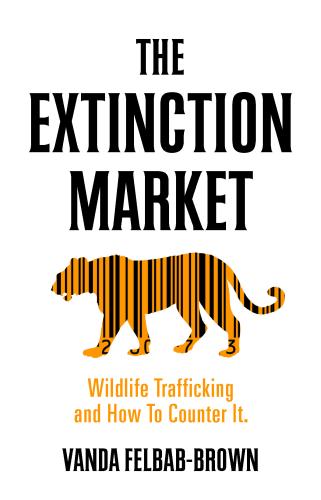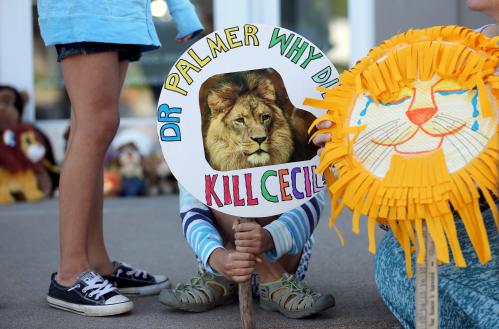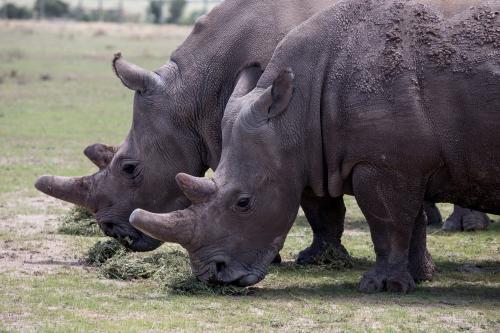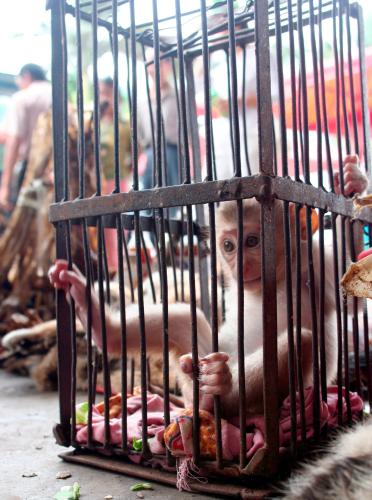Trophy hunting can critically contribute to biodiversity conservation, writes Vanda Felbab-Brown—it all depends on the specific case. Check out her new book, “The Extinction Market: Wildlife Trafficking and How to Counter It.” This piece originally appeared in The Hill.
President Trump’s suspension of the Interior Department’s decision to allow U.S. imports of elephant trophies from Zimbabwe and Zambia is a welcome step in the administration’s otherwise dismal environmental record.
The Obama administration’s import ban on those two countries should remain in place. But trophy hunting can critically contribute to biodiversity conservation. It all depends on the specific case.
Allowing some hunting can give hunters, ranchers and local communities a stake in preserving a species and the entire ecosystem. Managed hunting can reduce pressure to convert land from its natural state to cattle ranching or agriculture.
Often, competition for land between landowners and rural communities on the one hand and wildlife on the other puts wildlife at great risk, as landowners and rural populations see wildlife as pests. Without money earned from wildlife, landowners and local residents may have no stake in species and ecosystem preservation.
Managed hunting can earn revenues for landowners and perhaps even raise the standard of living of poor communities.
Although many Western conservationists shudder, community-sponsored trophy hunting, even of elephants and lions, under a program named Campfire, made Zimbabwe in the late 1980s and 1990s the poster child of community-based natural resource management: Some poor communities prospered while animal populations increased.
Furthermore, hunting revenues can be channeled to underpaid and under-equipped rangers to improve their capacity and reduce susceptibility to corruption.
But these positive outcomes don’t always materialize. The first issue is whether legal licenses and hunting quotas are handed out wisely and sustainably. As in any industry, such as fishing, lobbies often pressure governments to issue unsustainably high permits even at the cost of species collapse.
Beyond threatened species, it makes good sense to severely restrict hunting of top predators and keystone species on which the health of the ecosystem depends. Issuing a hunting license for a zebra or an antelope is much less risky than for a lion or rhino.
Still, exceptions could be made: Issuing a hunting license for a sick or old lion that will no longer breed, for example, is more appropriate than for a healthy breeding animal.
Corruption in licensing can also be a massive problem. If licenses are systematically faked—issued for bribes in excess of quotas, or never checked—the presumed conservation benefits of legal trophy hunting can be nil.
Trophy hunting can also encourage breeding programs for animals: sometimes good, often problematic. In South Africa, for example, lions are bred in deplorable conditions to keep numbers high enough for a lot of hunting licenses, which led to the Obama decision to prohibit the import of captive-bred lions from fenced enclosures.
There is also the question of whether the intended conservation recipients —the poor local communities, landowners and protected areas—actually get the hunting revenues. Often, the money is stolen by government and park officials or captured by few landowners without being invested in conservation.
Moreover, where legal and illegal trade coincide, licensing complicates law enforcement. It is not easy or straightforward for enforcement to ensure that a legally-certified scheme does not serve to launder illegally-hunted animals. In fact, in various parts of Africa, trophy hunting has been a cover for illegal wildlife trade.
Finally, permitted trophy hunting may encourage demand for such trophies beyond sustainable hunts. If pervaded by illegally-obtained licenses, it may only whitewash consumers’ consciousness.
In short, the success of wildlife management through trophy and community hunting depends on the quality of governance and law enforcement and whether the demand for particular animal parts is declining or increasing.
In the case of Zimbabwe and Zambia, most of these problems have been present for several years. In Zimbabwe, corruption pervades hunting licensing and poor and politicized law enforcement. The Mugabes and their cronies have usurped all kinds of natural resources on massive scale, including from wildlife.
Grace Mugabe also has been accused of forcibly displacing local communities from land for her private preserves. The recent coup in Zimbabwe gives no assurance that governance and law enforcement will improve.
Zambia’s park enforcement also has been poor, with rangers underfunded. Local communities have been marginalized in obtaining resources from wildlife conservation, while poverty and population growth increasingly push them into protected areas.
Corruption has pervaded trophy hunting licensing. And both countries have suffered significant declines of elephant populations from poaching.
In reviewing its trophy hunting policy, the Trump administration should focus on what it seemingly loathes: science and data.
Rather than stuffing its new International Wildlife Conservation Council with hunting lobbyists, it should place conservation scientists on its board, including those who support hunting, as well as law enforcement, governance and corruption experts. And the council should make its evaluation processes and decisions fully transparent.







Commentary
On the vices and virtues of trophy hunting
November 27, 2017